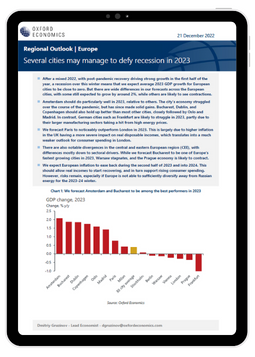Several European cities may manage to defy recession in 2023

After a mixed 2022, with post-pandemic recovery driving strong growth in the first half of the year, a recession over this winter means that we expect average 2023 GDP growth for European cities to be close to zero. But there are wide differences in our forecasts across the European cities, with some still expected to grow by around 2%, while others are likely to see contractions.
What you will learn:
- Amsterdam should do particularly well in 2023, relative to others. The city’s economy struggled over the course of the pandemic, but has since made solid gains. Bucharest, Dublin, and Copenhagen should also hold up better than most other cities, closely followed by Oslo and Madrid. In contrast, German cities such as Frankfurt are likely to struggle in 2023, partly due to their larger manufacturing sectors taking a hit from high energy prices.
- We forecast Paris to noticeably outperform London in 2023. This is largely due to higher inflation in the UK having a more severe impact on real disposable incomes, which translates into a much weaker outlook for consumer spending in London.
- There are also notable divergences in the central and eastern European region (CEE), with differences mostly down to sectoral drivers. While we forecast Bucharest to be one of Europe’s fastest growing cities in 2023, Warsaw stagnates, and the Prague economy is likely to contract.
Tags:
Related Services

Service
European Cities and Regions Service
Regularly updated data and forecasts for 2,000 locations across Europe.
Find Out More
Service
City Scenarios
The depth of our data services, the expertise of our economists, our global modelling capabilities, and our technical expertise allow us to tailor data, forecasts and scenarios to your specifications.
Find Out More
Service
Global Cities Service
Make decisions about market and investment strategies with historical data and forecasts for 1,000 of the world’s most important cities.
Find Out More